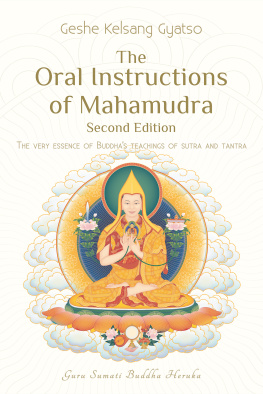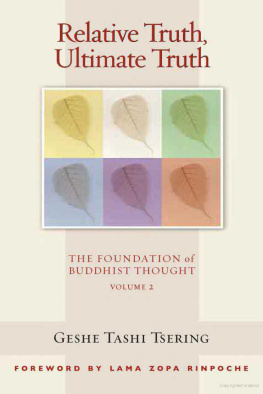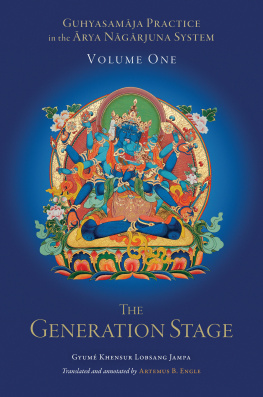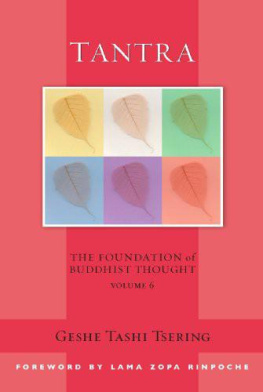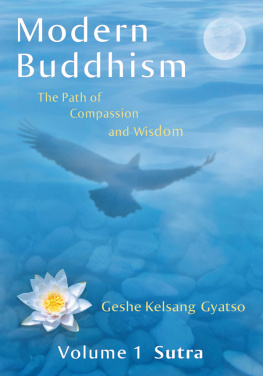Contents
- A SIGNIFICANT SIGHT BY SANGGYE YESHE
Commentary by Geshe Jampa Gyatso
An unbelievably powerful purification practice, which enables us to accumulate extensive merit.
Lama Zopa Rinpoche, from the foreword
I n Purification in Tibetan Buddhism Geshe Jampa Gyatso explains the popular and effective daily purification practice, The Bodhisattvas Confession of Downfalls, which includes the practice of prostration to the thirty-five confession buddhas and the recitation of their names. This practice is a potent and essential method for both beginners and advanced practitioners to gain higher spiritual attainments. In his delightfully conversational manner, Geshe-la teaches us the details of the law of cause and effect, the powerful use of the four opponent powers, and the proper manner and movements of prostrating, and provides clear descriptions of each of the thirty-five confession buddhas.
Foreword
Students, all my brothers and sisters in the Dharma, this book contains The Bodhisattvas Confession of Downfalls, a practice for purifying negativities and downfalls, together with a commentary by Geshe Jampa Gyatso. Geshe-la is a highly qualified virtuous friend who possesses the three most important qualities of merit, warm heart, and pure morality. He has been teaching Dharma for many years in the West, particularly in Italy, and has been extremely kind to innumerable Westerners.
When we have enough merit, we will be able to understand the reasons why the practice of the Confession of Downfalls should be done by everyone who wants happiness and does not want suffering. Success in achieving happiness and avoiding problems, both now and in the future, depends upon two requisites. These requisites function whether we believe in them or not. For example, we might not believe that a particular tiny seed planted in the ground can grow into a tree with thousands of branches covered in leaves, so huge that it can provide shade for five hundred horse carriages; however, that does not mean that this tree does not exist. In fact, there is such a tree in India, the nyagrodha tree. Likewise, even though we may not believe in reincarnation and the law of action and result, nor believe that this practice purifies our negativities, frees us from obstacles to generating the realizations of the path to enlightenment, frees us from the problems of this life and future lives, such as obstacles, illnesses, disharmony, harm, bad treatment, and abuse by others, and brings happiness and peace, both worldly and ultimate, it does not signify that this practice does not function to do so. Similarly, if we were to explain to a primitive person about rockets going to the moon, or about television, although he may not believe in the existence of these things, the mere fact that he does not believe in them does not mean that they do not exist. Reality is not necessarily as we believe it to be.
One of the requisites for success in achieving happiness and avoiding problems is to purify the causes of suffering, negativities created in the past. However, although this is of benefit, merely to purify them alone is not sufficient; we also need to stop committing negativities in the future, the second requisite for achieving happiness. We need to change our own mind and our own actions; otherwise, we would be like the elephant who goes into the water to wash only to emerge and once again lay down in the sandthere would never be an end to our purification practice. This is why the practice of the Confession of Downfalls (which is done in conjunction with the four opponent forces) includes the force of turning away from faults in the future, the determination to not commit a particular negative action again, i.e., henceforth, to live in morality. With these two requisites, the purification of negativities already committed and the abstention from committing them again, we can purify all obstacles to our happiness.
Why are we not able to perfectly work for the benefit of sentient beings, to free them from suffering and cause them to attain happiness, and, especially, to lead them to enlightenment? It is because we are sentient beings whose minds are obscured; if instead, we were enlightened beings, buddhas, we would not have any obscurations whatsoever in our mental continua and would be able to perfectly benefit others. Therefore, since the practice of purification enables us to purify negative actions, the obscurations that prevent us achieving the realizations of the path to enlightenment, it is extremely important. By engaging in it, we will be able to perfectly work to free sentient beings from the depthless ocean of suffering and lead them to happiness; the very purpose of our lives.
When we mindfully and correctly practice the Confession of Downfalls even once, it has the power to purify even very heavy negative actions, such as the five actions of immediate retribution. This is the reason why Lama Tsongkhapa performed many hundreds of thousands of prostrations in conjunction with the recitation of the names of the thirty-five buddhas. This practice is extremely powerful; in some texts it is said that just by reciting the first name, that of Guru Shkyamuni Buddha, eighty thousand eons of negativities are purified. In fact, the mere recitation of each of the names of the thirty-five buddhas has the power to purify many eons of different types of negative actions. When this practice is performed together with prostrations (even the mere folding of the hands together in front of a statue of Buddha), we accumulate inconceivable merit. Therefore, it would be a great loss if we were not to take advantage of this opportunity to do this practice. In short, The Bodhisattvas Confession of Downfalls, the recitation of the names of the thirty-five buddhas, particularly when done in conjunction with prostrations, is an unbelievably powerful purification, and enables us to accumulate extensive merit.
May this book composed by Geshe Jampa Gyatso greatly benefit numberless sentient beings by enabling them to purify their minds and achieve full enlightenment as quickly as possible.
Lama Thubten Zopa Rinpoche
Publishers Acknowledgments
The publisher thanks the Hershey Family Foundation, Chiu-Nan Lai, Fiorella Bonolis and Luigi Carpineti, Magda Cavalieri, Sante Cinti, Laura Coccitto, Istituto Lama Tzong Khapa, Joan Nicell, Tagden Shedrub Ling Monastery, and Thubten Tsognyi for their kindness in sponsoring the production of this book.
Editors Preface
The practices of purifying negativities and accumulating merit are the heart of the many methods taught in the Buddhist sutra and tantra teachings for attaining enlightenment. To gain any mental, or spiritual, development whatsoever, it is absolutely necessary to purify the negativities of body, speech, and mind that we have accumulated throughout our beginningless lives. These negativities have left imprints on our mental continuum that at some future time will ripen in the experience of suffering. Therefore, to avoid rebirth in the lower realms and the experience of unhappiness in future lives, and to gain liberation and enlightenment, it is essential to purify our mental continuum.
In addition to purifying negativities, we need to accumulate merit, or positive energy, to achieve enlightenment. This is done by engaging in virtuous actions, such as the practice of the six perfectionsgenerosity, morality, patience, joyous effort, concentration, and wisdom. By means of these practices a bodhisattva, a being who is striving to attain enlightenment, is able to accumulate the merit necessary to bring about the mental development that reaches its zenith in the state of complete omniscience.



